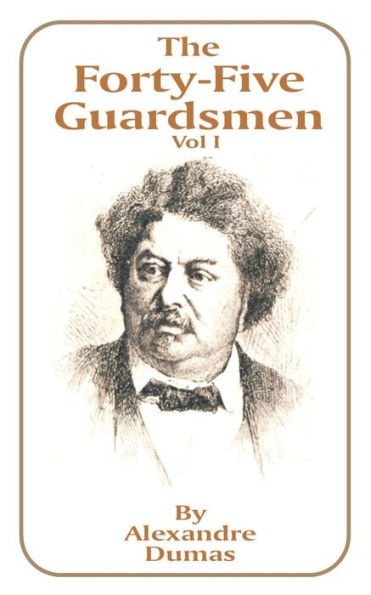The Forty-Five Guardsmen: Volume I
Alexandre Dumas (also known as Dumas père) (1802-1870) was one of the most famous French writers of the 19th century. Dumas is best known for the historical novels The Three Musketeers and The Count of Monte-Cristo, both written within the space of two years, 1844-45, and which belong to the foundation works of popular culture. He was among the first, along with Honoré de Balzac and Eugène Sue, who fully used the possibilities of roman feuilleton, the serial novel. Dumas is credited with revitalizing the historical novel in France, although his abilities as a writer were under dispute from the beginning. Dumas’ works are fast-paced adventure tales that blend history and fiction, but on the other hand, the are entangled, melodramatic, and actually not faithful to the historical facts.
Alexandre Dumas was born in Villes-Cotterêts. His grandfather was a French nobleman, who had settled in Santo Domingo (now part of Haiti); his paternal grandmother, Marie-Cessette, was an Afro-Caribbean, who had been a black slave in the French colony (now part of Haiti). Dumas’ father was a general in Napoleon's army, who had fallen out of favor. After his death in 1806 the family lived in poverty. Dumas worked as a notary’s clerk and went in 1823 to Paris to find work. Due to his elegant handwriting he secured a position with the Duc d’Orléans - later King Louis Philippe. He also found his place in theater and as a publisher of some obscure magazines. An illegitimate son called Alexandre Dumas fils, whose mother, Marie-Catherine Labay, was a dressmaker, was born in 1824. Dumas fils gained fame with his novel The Lady of the Camillas, in which a fallen girl, the heroine, gives up her lover rather than see him become a social outcast.
1004727565
The Forty-Five Guardsmen: Volume I
Alexandre Dumas (also known as Dumas père) (1802-1870) was one of the most famous French writers of the 19th century. Dumas is best known for the historical novels The Three Musketeers and The Count of Monte-Cristo, both written within the space of two years, 1844-45, and which belong to the foundation works of popular culture. He was among the first, along with Honoré de Balzac and Eugène Sue, who fully used the possibilities of roman feuilleton, the serial novel. Dumas is credited with revitalizing the historical novel in France, although his abilities as a writer were under dispute from the beginning. Dumas’ works are fast-paced adventure tales that blend history and fiction, but on the other hand, the are entangled, melodramatic, and actually not faithful to the historical facts.
Alexandre Dumas was born in Villes-Cotterêts. His grandfather was a French nobleman, who had settled in Santo Domingo (now part of Haiti); his paternal grandmother, Marie-Cessette, was an Afro-Caribbean, who had been a black slave in the French colony (now part of Haiti). Dumas’ father was a general in Napoleon's army, who had fallen out of favor. After his death in 1806 the family lived in poverty. Dumas worked as a notary’s clerk and went in 1823 to Paris to find work. Due to his elegant handwriting he secured a position with the Duc d’Orléans - later King Louis Philippe. He also found his place in theater and as a publisher of some obscure magazines. An illegitimate son called Alexandre Dumas fils, whose mother, Marie-Catherine Labay, was a dressmaker, was born in 1824. Dumas fils gained fame with his novel The Lady of the Camillas, in which a fallen girl, the heroine, gives up her lover rather than see him become a social outcast.
25.0
In Stock
5
1

The Forty-Five Guardsmen: Volume I
452
The Forty-Five Guardsmen: Volume I
452Paperback
$25.00
25.0
In Stock

Product Details
| ISBN-13: | 9781589631700 |
|---|---|
| Publisher: | International Law and Taxation Publishers |
| Publication date: | 04/01/2001 |
| Pages: | 452 |
| Product dimensions: | 5.06(w) x 7.88(h) x 1.11(d) |
About the Author

From the B&N Reads Blog
